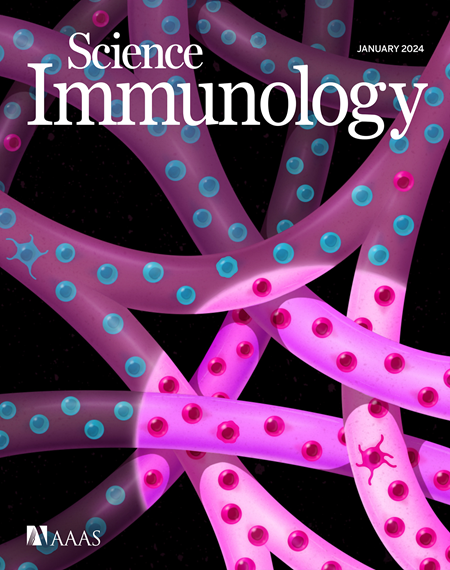Crystal structure of the human LAG-3–HLA-DR1–peptide complex
IF 16.3
1区 医学
Q1 IMMUNOLOGY
引用次数: 0
Abstract
T cell activity is governed by T cell receptor (TCR) signaling and constrained by immune checkpoint molecules, including programmed cell death protein 1 (PD-1), cytotoxic T lymphocyte–associated antigen 4 (CTLA-4), and lymphocyte activation gene 3 (LAG-3). The basis for how LAG-3 binds to human leukocyte antigen class II molecules (HLA-II) remains unknown. Here, we present the 3.4-angstrom crystal structure of a LAG-3–peptide–HLA-II complex and probe the energetics of the complex interface. Coincident with the HLA-II binding site of the ancestrally related, monomeric CD4 receptor, the LAG-3 homodimer laterally engages two HLA-II molecules via distal D1 domain surfaces, imposing a 38° angular offset. The LAG-3–HLA-II interface is discontinuous and lacks involvement of the D1 extra loop, a binding site for anti–LAG-3 therapeutic monoclonal antibodies. Upon HLA-II binding, intrinsically mobile loops of the LAG-3 molecule become ordered, with contact residues highly conserved across HLA-DR, DQ, and DP allomorphs. Our data provide a structural foundation for development of immunomodulatory approaches targeting LAG-3.
人lag -3 - hla - dr1肽复合物的晶体结构
T细胞活性受T细胞受体(TCR)信号控制,并受免疫检查点分子的约束,包括程序性细胞死亡蛋白1 (PD-1)、细胞毒性T淋巴细胞相关抗原4 (CTLA-4)和淋巴细胞激活基因3 (LAG-3)。LAG-3如何与人类白细胞抗原II类分子(HLA-II)结合的基础仍然未知。在这里,我们展示了LAG-3-peptide-HLA-II配合物的3.4埃晶体结构,并探测了配合物界面的能量学。与祖先相关的单体CD4受体的HLA-II结合位点一致,LAG-3同二聚体通过远端D1结构域表面横向结合两个HLA-II分子,形成38°角偏移。LAG-3-HLA-II界面是不连续的,缺乏D1额外环的参与,D1额外环是抗lag -3治疗性单克隆抗体的结合位点。HLA-II结合后,LAG-3分子的内在移动环变得有序,接触残基在HLA-DR、DQ和DP异型中高度保守。我们的数据为开发针对LAG-3的免疫调节方法提供了结构基础。
本文章由计算机程序翻译,如有差异,请以英文原文为准。
求助全文
约1分钟内获得全文
求助全文
来源期刊

Science Immunology
Immunology and Microbiology-Immunology
CiteScore
32.90
自引率
2.00%
发文量
183
期刊介绍:
Science Immunology is a peer-reviewed journal that publishes original research articles in the field of immunology. The journal encourages the submission of research findings from all areas of immunology, including studies on innate and adaptive immunity, immune cell development and differentiation, immunogenomics, systems immunology, structural immunology, antigen presentation, immunometabolism, and mucosal immunology. Additionally, the journal covers research on immune contributions to health and disease, such as host defense, inflammation, cancer immunology, autoimmunity, allergy, transplantation, and immunodeficiency. Science Immunology maintains the same high-quality standard as other journals in the Science family and aims to facilitate understanding of the immune system by showcasing innovative advances in immunology research from all organisms and model systems, including humans.
 求助内容:
求助内容: 应助结果提醒方式:
应助结果提醒方式:


